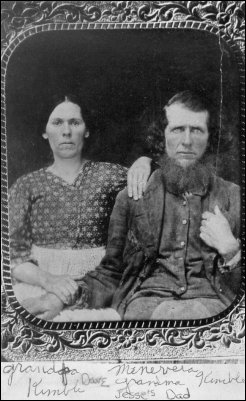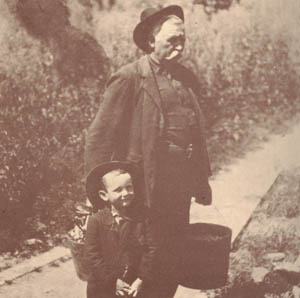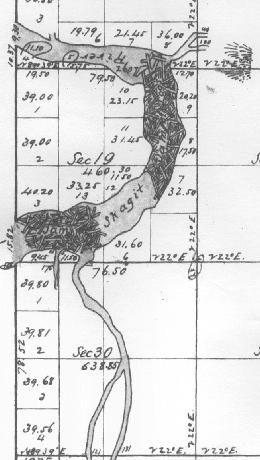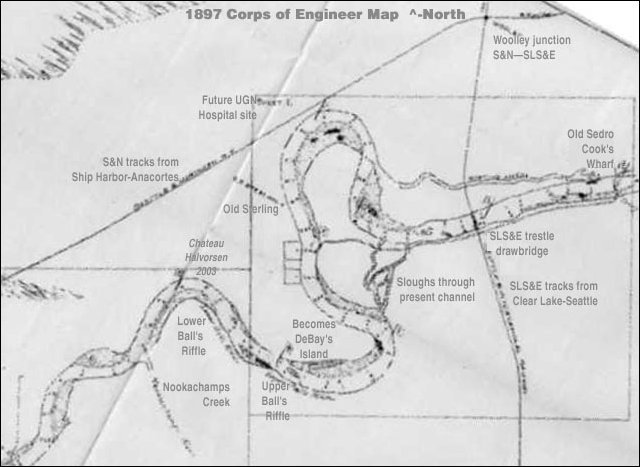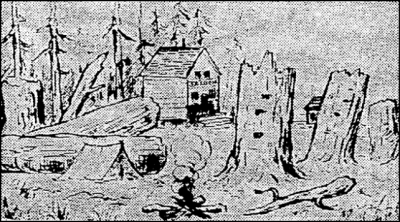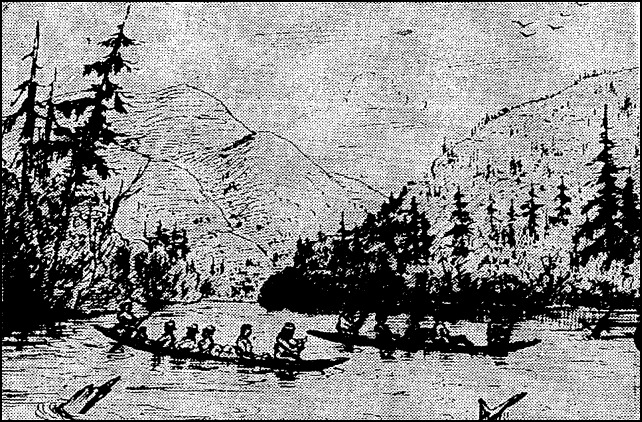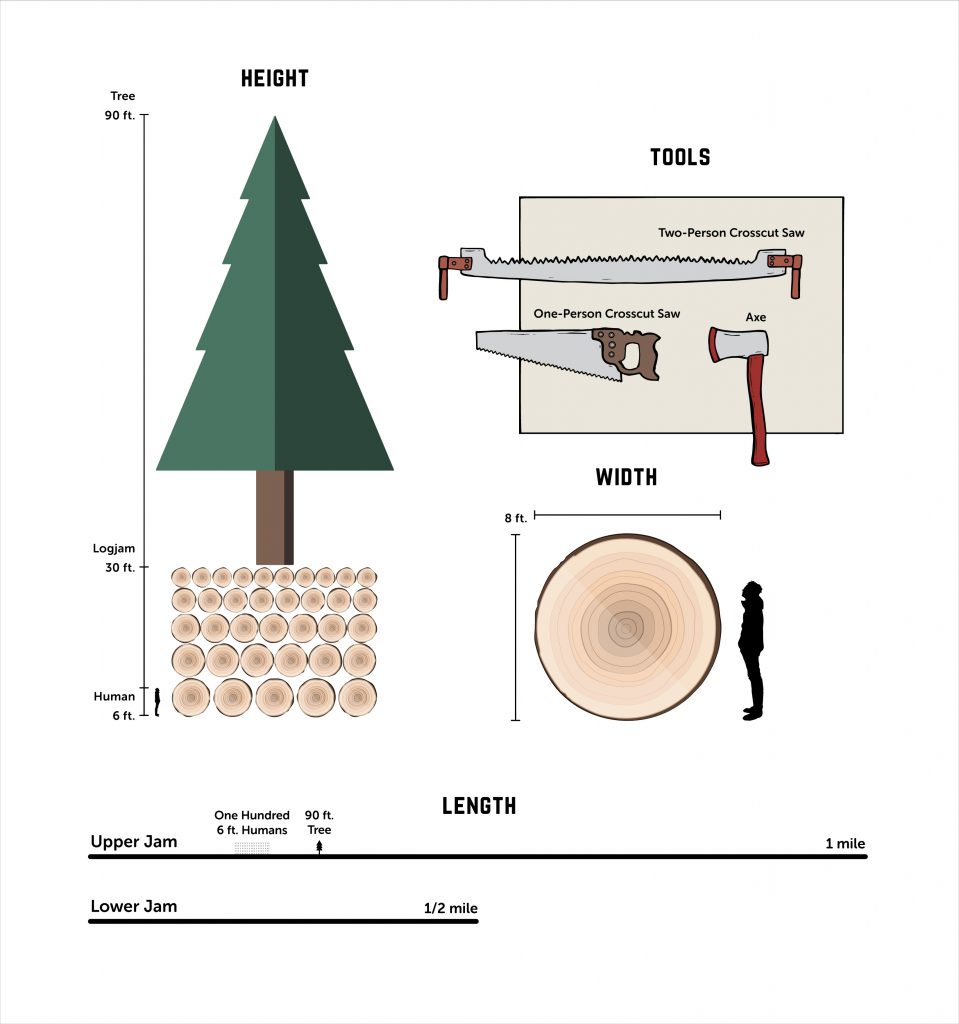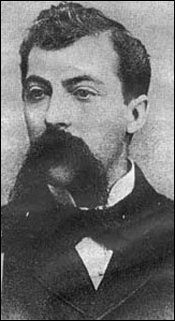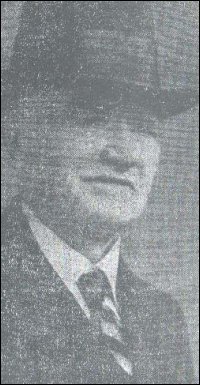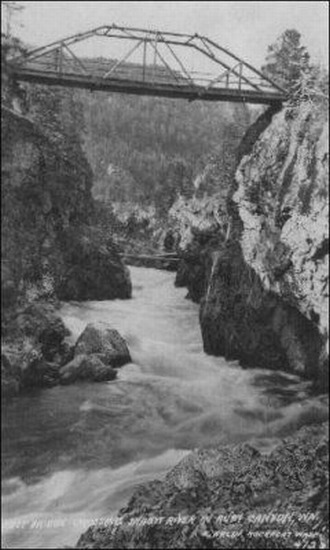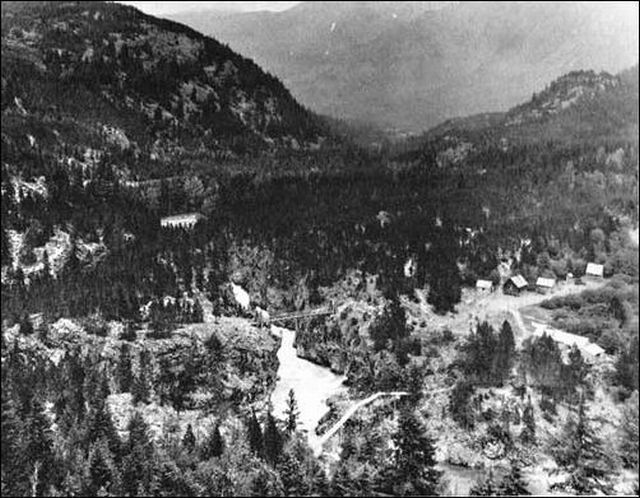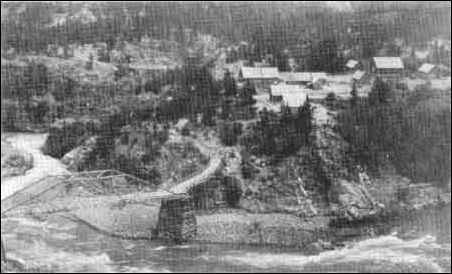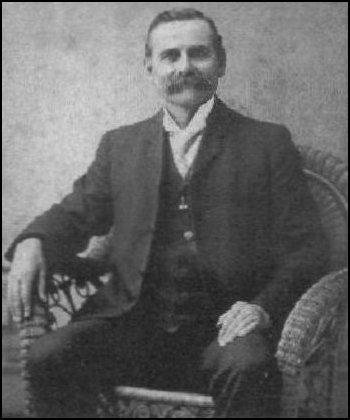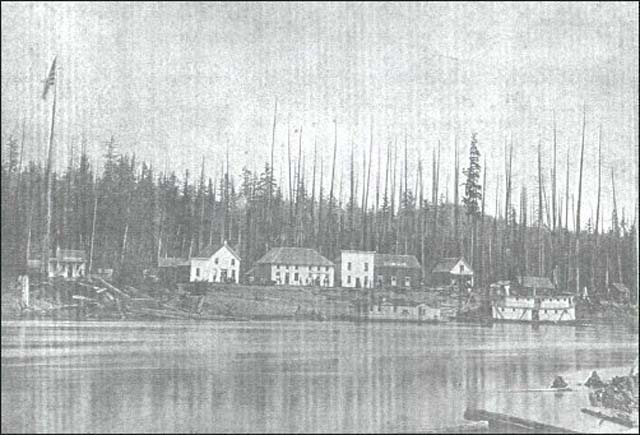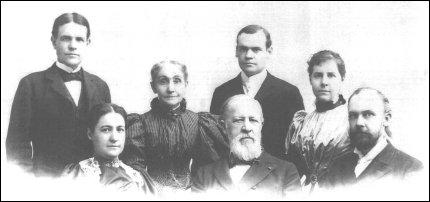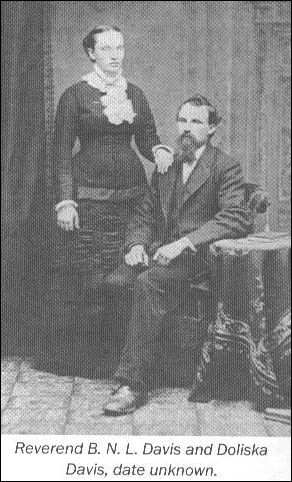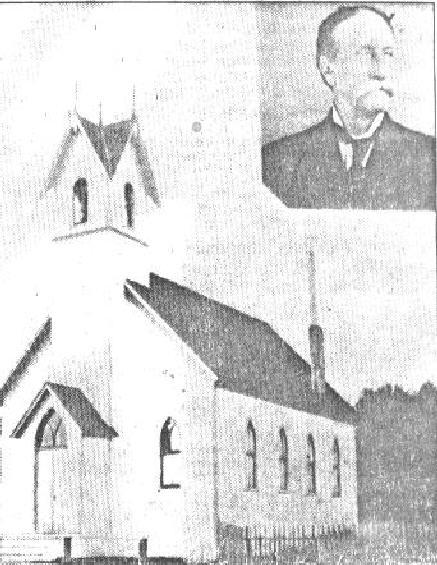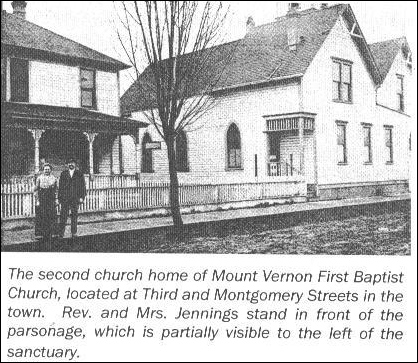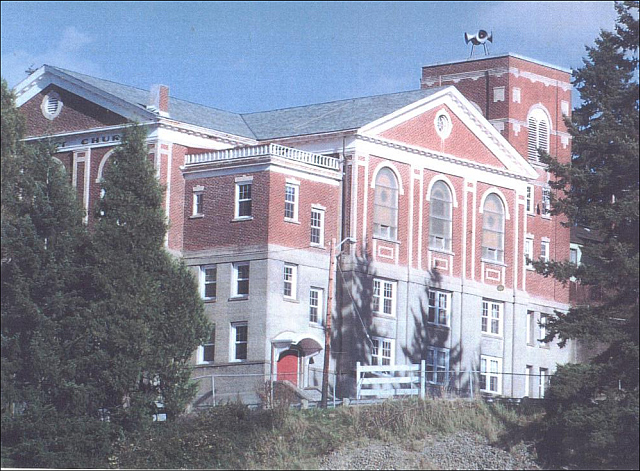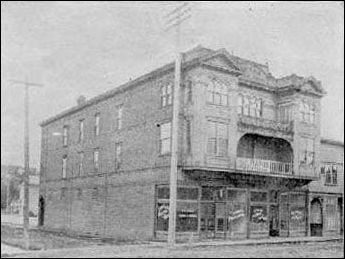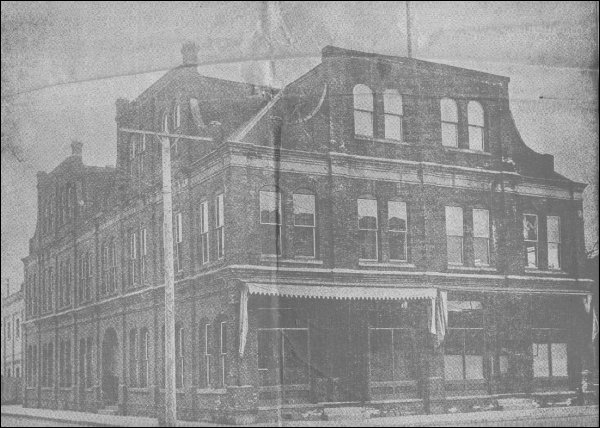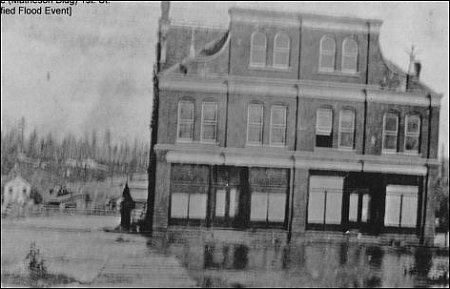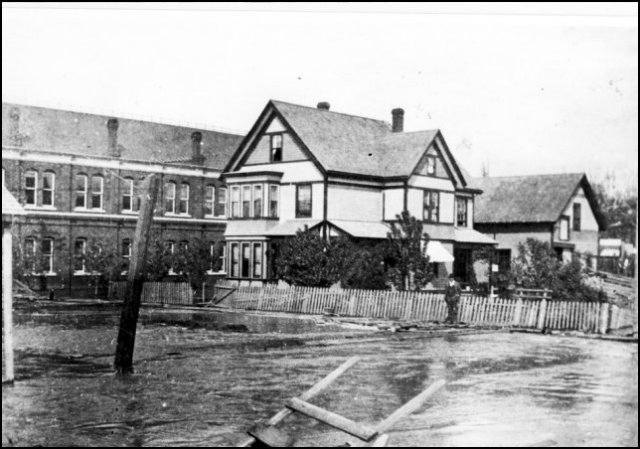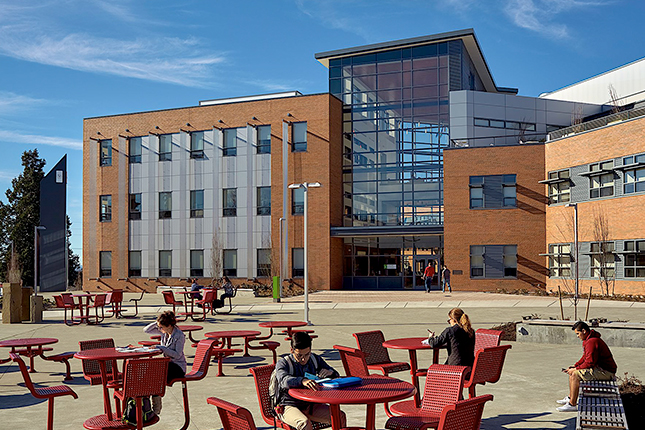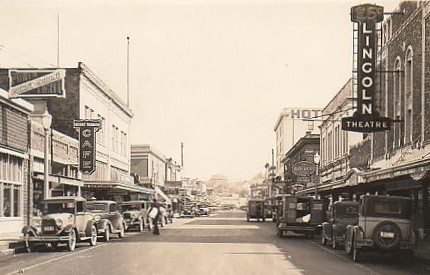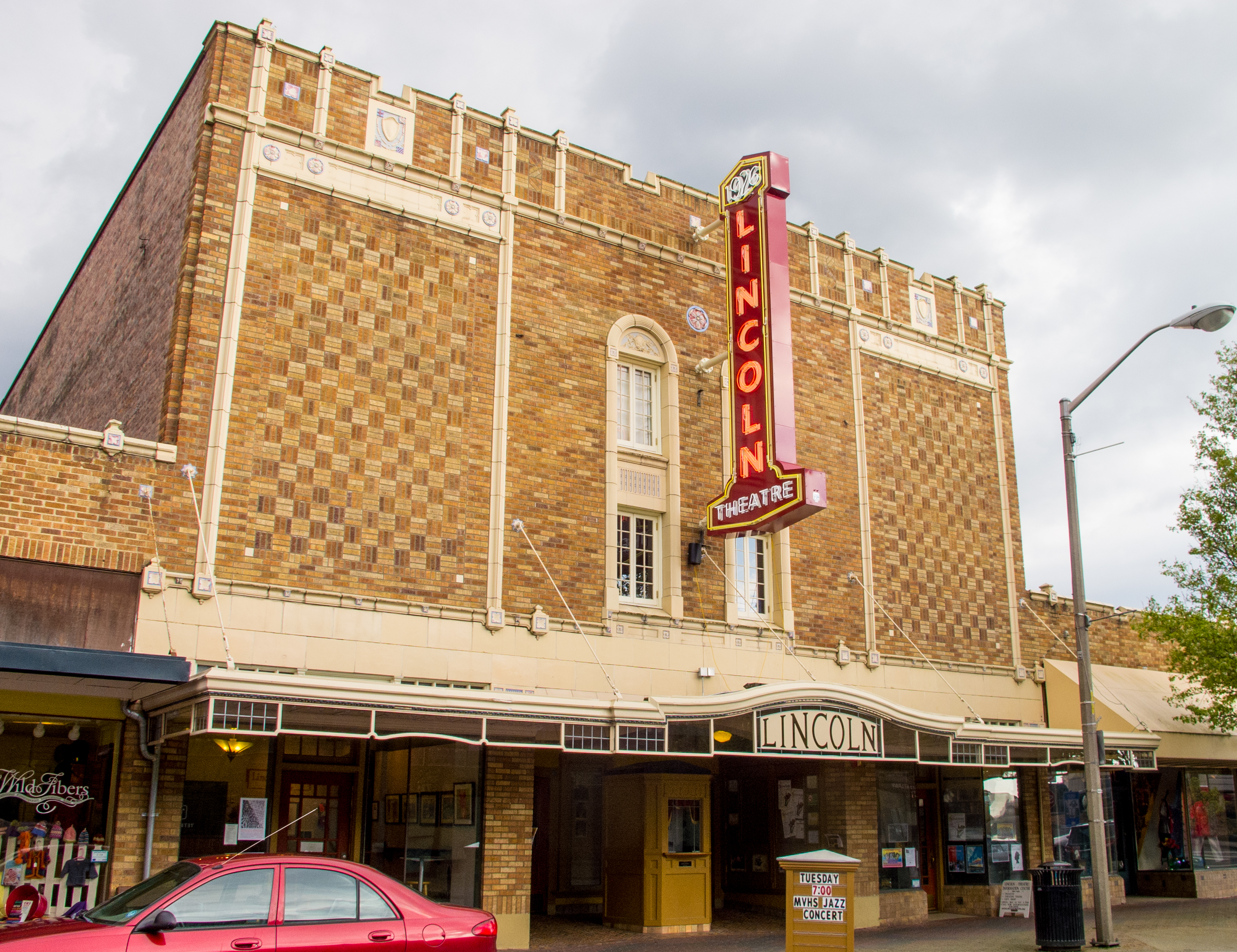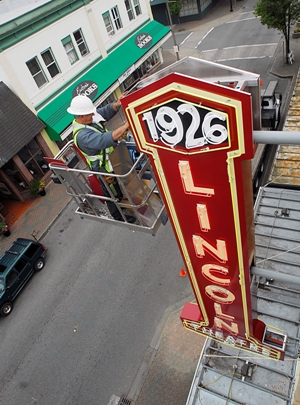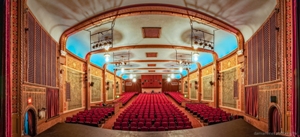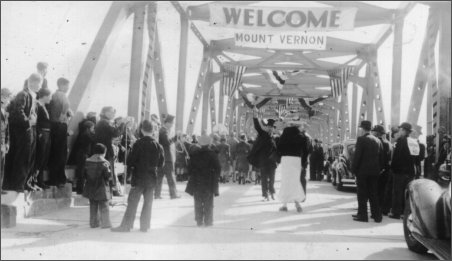1800–1899
First Euro-American Settlers
David E. Kimble (1828-1908), Jasper Gates (1840-1923), and Joseph F. Dwelley (1839-?), who in 1869 and 1870 homesteaded on land near what was to become Mount Vernon, and in Gates case, on the very site where the town would first be built. In late 1870 several women, including the wives of Kimble and Gates, arrived on the vessel Linnie, which was the first steamer to make it as far as the lower logjam, and Dwelley’s wife and two children joined him the following year.
Sources
› http://www.historylink.org/File/9537
› http://www.skagitriverjournal.com/WestCounty/MV/Pioneers/Pre1900/Kimble/Kimble01-BioFamily.html
Skagit River Logjams
About 10 miles upriver and very near present-day Mount Vernon, before the point where the river divides and flows into Skagit Bay, two massive logjams blocked all navigation. The logjams may have dated back to reported eruptions of Mount Baker in the 18th century, but however formed, they were massive, and the upper jam grew every year as more natural debris made its way downriver.
The logjams were so dense and long-established that living trees up to 90 feet tall grew from them. Together, the two obstructions rendered the river largely useless in both directions. Goods could not make it to Mount Vernon by river from towns closer to the salt water, and the wealth of the interior—lumber, coal, and minerals alike—could not be rafted or barged down from their source to mills and markets accessible from Skagit Bay.
Sources
› http://www.historylink.org/File/9537
Clearing the Logjams
After a failed attempt to receive assistance from the federal government, a group of settlers formed a company in 1876 to take on the logjam themselves. The effort was initially funded by public subscription, and the men had hopes that much of the cost would be recouped through the sale of logs salvaged from the jam.
By December 16, 1876, using crosscut saws and axes, they had cut through five to eight tiers of logs 3–8 feet in diameter, totaling 30 feet deep. It took them six months to cut a 250-foot channel through the lower obstruction. Floods, which sometimes wedged the logs together, complicated their progress; but by the next summer, the men were cutting into the upper jam. It was laborious and highly dangerous work, but they kept at it.
In the summer of 1879, the drift was sufficiently opened to permit navigation through and above Mount Vernon, but at a substantial personal cost to those who had risked their lives to do it. The seven men who were most involved in the effort—Joseph S. Wilson, Dennis Storrs, James Cochrane, Fritz Dibbern, Daniel Hines, Marvin Minnick, John Quirk, and Donald McDonald—each ended up (to $1,000) in debt, and the great bulk of the logs removed from the jam proved rotten and of no commercial value.
Sources
› http://www.historylink.org/File/9537
› http://historylink.org/File/5652
Founding of Mount Vernon
In 1877, Harrison Clothier (1840-1906), a teacher who had come west from Saratoga, New York, made it up the river. He and Edward G. English (1850- 1930), a former pupil from Clothier’s teachings days in Wisconsin, bought 10 acres from Jasper Gates for $100, opened a store, and prepared a town plat (the original of which was never recorded, and thus of dubious validity). They named their aspiring community Mount Vernon, after the Virginia home of the nation’s first president.
Sources
› http://www.historylink.org/File/9537
First Store
Upon the founding of Mount Vernon, [Harrison] Clothier became the town’s first postmaster, and in later years, doing business as “Clother & English,” he and his partner, Edward G. English, played leading roles in the political and business development of the area.
Sources
› http://www.historylink.org/File/9537
Ruby Creek Gold Rush
[Otto Klement, experienced gold prospector Jack Rowley, and a few upriver pioneers] set out again in the spring of 1878 and found placer gold on several tributaries of the upper Skagit, mainly around Ruby creek. The results were promising and the prospectors tried to keep a lid on their discovery, but by 1879 the Seattle Post-Intelligencer let the cat out of the bag and the arrival of prospectors started building.
That was year that F. Albert Bacon, a newcomer from Maine, staked his Nip and Tuck claim that led to an avalanche of miners in the spring of 1880. The hotels of Mount Vernon were bulging…that year.
Sources
› http://www.historylink.org/File/9537
› http://www.skagitriverjournal.com/WestCounty/MV/Pioneers/Pre1900/ClothierEnglish1-EarlyMV1.html
› http://www.skagitriverjournal.com/Upriver/Mines/RCreek/RubyCreek01-1880P-IClips.html
› http://www.skagitriverjournal.com/Portal/UpriverSec.html
› http://www.skagitriverjournal.com/Upriver/Mines/RCreek/RubyCreek02-1880P-IClips-2.html
Ruby Hotel
Photo 1
“This photo supplied by reader Larry Harnden shows a view of the Mount Vernon waterfront on the Skagit river as we look northeast. The building at the right center with a group of men standing before it is Ruby Hotel, opened by Michael McNamara to house some of the argonauts of the short-lived 1880 gold rush on Ruby creek, a tributary of the upper Skagit. We believe that the building at the far left is the Mount Vernon House, owned by Brann and Moran.”
Photo 2
“This view is of the east side of the Skagit, about where downtown Mount Vernon is now. Various publications indicate either 1879 or 1881; the village of Mount Vernon began in 1877. The photographer was standing about where the west end of the bridge to Mount Vernon and the Memorial highway is now.”
Sources
› http://www.stumpranchonline.com/skagitjournal/SkagitCtyRiv/Library/County/SNews188403-4.html
› http://www.stumpranchonline.com/skagitjournal/WestCounty/MV-SW/MVPh1.html
1881 • Population 75
Skagit News
The town’s first newspaper, the Skagit News, was started by publisher William C. Ewing. Under different ownership it continued publication with that name for 12 years, then became the Skagit Valley News in 1897, the Mount Vernon Herald in 1913, and in 1956, the Skagit Valley Herald, which still publishes today.
Sources
› http://www.historylink.org/File/9537
› http://www.skagitriverjournal.com/SCounty/Library/Newspapers/MV/SNews/Ewing1-Profile.html
Mount Vernon Takes County Seat
LaConner was selected as the first seat of government for this new Skagit County, but in November 1884, voters selected Mount Vernon as the county seat.
Sources
› http://www.historylink.org/File/9537
Larger School
Enrollment of 19 boys and 26 girls.
Sources
› http://www.historylink.org/File/9537
Early Economic Development
By 1890 Mount Vernon’s population had grown to nearly 1,000, supported by logging and mining to the east and farming in the fertile bottomlands of the Skagit Valley. Skagit County’s abundant resources—minerals in the mountains, seemingly endless stands of old-growth timber, rivers teeming with fish, and some of the most fertile soil in the world deposited in the valley by the Skagit River—were attracting new settlers to the inland areas.
Town founders, Clothier & English, had crews out logging the forests east of town and were soon selling several hundred thousand feet of logs to the Bellingham Mill Company.
Sources
› http://www.historylink.org/File/9537
First General Election
On June 27 the city held its first municipal election, and C. D. Kimball (despite the different spelling, this was the son of early settler David Kimble) was elected mayor, together with a five-man city council. Together, they then appointed other city functionaries, including a city clerk, a marshal, and a police court judge.
Sources
› http://www.historylink.org/File/9537
First Baptist Church
Mount Vernon’s First Baptist Church was founded by B. N. L. Davis on April 27, 1884, … The beginning congregation of four members had no building of its own, but by 1885 had secured two lots on the corner of First and Division. By 1885 there were ten members but no Sunday School. The growing congregation also began to build its first church building, and in 1887 it had “a house enclosed.” Even so, it was some time before the church was finished and furnished sufficient for dedication, which did not take place until November 17, 1889.
Sources
› http://www.historylink.org/File/9537
› http://www.skagitriverjournal.com/WestCounty/MV/Pioneers/Pre1900/Davis1/BNLDavis02-Chimes.html
Commercial District Fire
A devastating fire destroyed most of the riverside commercial district, and much of it was rebuilt on 1st Street, a little farther back from the banks of the Skagit.
Sources
› http://www.historylink.org/File/9537
› http://www.skagitriverjournal.com/WestCounty/MV/Pioneers/Pre1900/Davis1/BNLDavis02-Chimes.html
First Opera House
Sources
› http://www.historylink.org/File/9537
› http://www.skagitriverjournal.com/Portal/WishList.html
Skagit County Courthouse
The Skagit County courthouse had stayed in LaConner after Mount Vernon became county seat, and this was a source of considerable irritation. The slight was remedied in 1893 when the courthouse was packed up and moved to a substantial new building in downtown Mount Vernon. That building, its third-floor garrets now gone, still stands today (2010).
Sources
› http://www.historylink.org/File/9537
› http://www.skagitriverjournal.com/SCounty/Gov/CourthouseFight1909.html
› http://www.skagitriverjournal.com/WestCounty/MV/Pioneers/Pre1900/MillionEC.html
First Bridge
The city’s first bridge across the Skagit, a wooden-truss structure with a draw-span to allow vessels to pass, was opened, supplementing a ferry that had been operating nearby for several years.
Sources
› http://www.historylink.org/File/9537
1900–1999
1900 • Population 1,120
A Review of the Resources
A government publication from 1905 had the following to say:
“[Mount Vernon] is in a wonderfully rich part of the valley and surrounded by farms noted for their huge crops of oats, potatoes, hops and grass … Having both water and rail transportation the town is in good shape for business of every kind. At the present time the town is essentially agricultural, though admirably adapted for some manufacturing purposes. Dairying is one of the chief occupations of the nearby farmers. Probably 3,000 cows are within a radius of six miles of the town. There are large lumber mills, shingle mills, dairies, a bank, two weekly papers, the ‘Argus’ and ‘News-Herald’ … The chief exports are hay, oats, lumber, shingles, butter, vegetables, cattle, fruit and hops …” (A Review of the Resources, 163).
Sources
› http://www.historylink.org/File/9537
Largest Flood
After the logjams were cleared in the 1870’s, frequent floods bedeviled the city… The largest flood on record up to that time came in 1909, and it was said that “it was possible to row a boat all the way from Mt. Vernon to LaConner across the fields.” Other serious floods came in 1917, 1921, 1951, 1975, 1990, 2003, and 2006.
Sources
› http://www.historylink.org/File/9537
1910 • Population 2,381
Chamber of Commerce
Mount Vernon’s Chamber of Commerce was founded in 1917 and originally called the Commercial Club.
Sources
› http://www.mountvernonwa.gov/Index.aspx?NID=321
Hillcrest Park
Lincoln Theatre
Mount Vernon has kept a great number of its historical buildings intact. The venerable Lincoln Theater, first opened in 1926 as a vaudeville and silent movie house, is listed on the National Register of Historic Places.
When the Lincoln Theatre was built, it was hailed for its originality and beauty. The original owner, Eldon Weigel Pollock, enlisted noted Seattle architect William Aitken to design the Lincoln in a modified Renaissance Revival style. Manager Edwin Halberg (business partner of Pollock) personally designed the luxurious carpet, the decorative effect on the walls, the hangings and draperies, and the lighting effects. The primary colors were blue, yellow, and red. The foyer was lit with quaint, wrought-iron lanterns with Spanish design patterns. The walls have what’s known as a travertine finish.
Sources
› http://www.historylink.org/File/9537
› https://www.lincolntheatre.org/history
› http://www.skagitriverjournal.com/WestCounty/MV/Pioneers/Pre1900/Decatur1-Bio.html
Riverside Bridge
“For those of you who have been watching closely the construction of the new bridge that spans the Skagit river at Riverside, here is a photo from the opening of the old bridge in 1938… Photo courtesy of Betty Osborne Hittson from the Harry Osborne collection.”
Sources
› http://www.stumpranchonline.com/skagitjournal/WestCounty/MV-SW/MVPh1.html
1980 • Population 13,000
Skagit Valley Hospital
After a 1955 bond issue pushed by the city’s Women’s Guild passed with a 92-percent “yes” vote, construction began on Skagit Valley Hospital, which was completed in 1958. It has continued to grow over the years and is now the major provider of comprehensive health care for the county.
Sources
› http://www.mountvernonwa.gov/Index.aspx?NID=321
Skagit Valley Tulip Festival
The Skagit Valley Tulip Festival was officially inaugurated by the Mount Vernon Chamber of Commerce in 1984. A decade later, the festival broke off from the Chamber of Commerce and became its own entity.
Sources
› http://www.tulipfestival.org/history
Best Small City in America
In 1998, Mount Vernon was rated the #1 “Best Small City in America” by the New Rating Guide to Life in America’s Small Cities.
Sources
› https://web.archive.org/web/20070517231411/http://www.livemountvernon.com
› https://www.amazon.com/Rating-Guide-Americas-Small-Cities/dp/0879755997
2000–Present
Skagit Transportation Center
The new Skagit Station in Mount Vernon delivers true multimodal transportation to a rapidly growing region. Commuters and travelers are able to converge on a central location in downtown Mount Vernon to switch between Skagit Transit bus, Greyhound bus, Amtrak rail and local taxi.
Sources
› http://www.djc.com/news/co/11161148.html
Flood Wall, Phase I
The city has steadily refined its efforts to hold back the [Skagit River] flood waters, including the purchase of a 1,500-foot portable flood wall that could be erected by fewer than a dozen people in about four hours and is hoped to be a vast improvement over labor-intensive sandbags.
Phase I
Flood wall and river trail from Division Street Bridge to Lions Park. (Completed October 2010)
Sources
› http://www.historylink.org/File/9537
› http://www.mountvernonwa.gov/index.aspx?NID=504
2010 • Population 32,000
Flood Wall, Phase II & III
Phase II
Included flood wall engineered to protect historic downtown Mount Vernon, 1,650 linear feet of flood wall, 24-ft wide riverwalk and trail connection to regional trail system, 30,000 square foot Public Riverfront Park. (Completed April 2016)
Phase III
Project construction is underway and expected to be complete in the Fall of 2017. This phase includes 1.4 miles of flood wall and earthen levee and .9 miles of riverwalk and trail connection to regional trail system. (Construction Underway)
Sources
› http://www.mountvernonwa.gov/index.aspx?NID=504
Thank You
We greatly appreciate the time and effort taken to compile the historical information that helped us construct this historical timeline of Mount Vernon.
Timeline information was pulled from the following websites:

